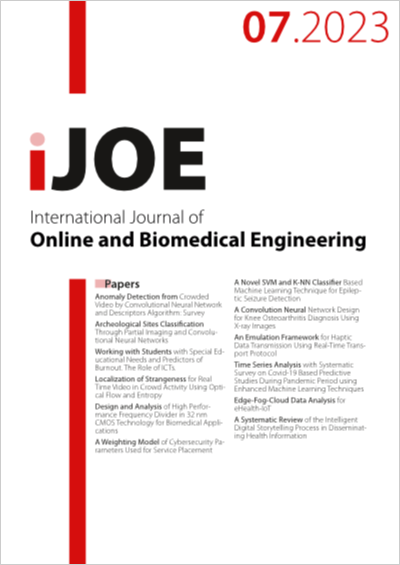Edge-Fog-Cloud Data Analysis for eHealth-IoT
DOI:
https://doi.org/10.3991/ijoe.v19i07.38903Keywords:
IoT, Machine Learning, eHealth, Cloud, Fog, EdgeAbstract
Thanks to advancements in artificial intelligence and the Internet of Things (IoT), eHealth is becoming an increasingly attractive area for researchers. However, different challenges arise when sensor-generated information is stored and analyzed using cloud computing. Latency, response time, and security are critical concerns that require attention. Fog and Edge Computing technologies have emerged in response to the requirement for resources near the network edge where data is collected, to minimize cloud challenges. This paper aims to assess the effectiveness of Machine Learning (ML) and Deep Learning (DL) techniques when executed in Edge or Fog nodes within the eHealth data. We compared the most efficient baseline techniques from the state-of-the-art on three eHealth datasets: Human Activity Recognition (HAR), University of Milano Bicocca Smartphone-based Human Activity Recognition (UniMiB SHAR), and MIT-BIH Arrhythmia. The experiment showed that for the HAR dataset, the Support Vector Machines (SVM) model was the best performer among the ML techniques, with low processing time and an accuracy of 96%. In comparison, the K-Nearest Neighbors (KNN) performed 94.43, and 96%, respectively, for SHAR and MIT-BIH datasets. Among the DL techniques, the Convolutional Neural Network with Fourier (CNNF) model performed the best, with accuracies of 94.49% and 98.72% for HAR and MIT-BIH. In comparison, CNN achieved 96.90% for the SHAR dataset.
Downloads
Published
How to Cite
Issue
Section
License
Copyright (c) 2023 CHAIMAE ZAOUI, Faouzia Benabbou, Abdelaziz Ettaoufik

This work is licensed under a Creative Commons Attribution 4.0 International License.



